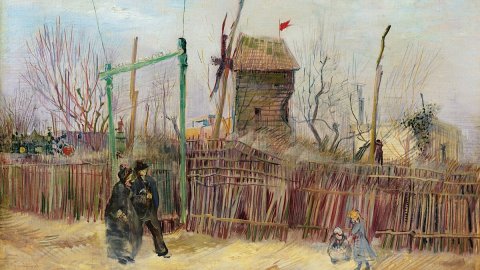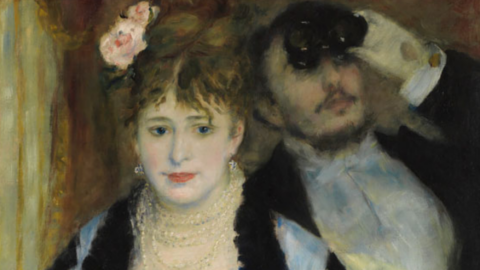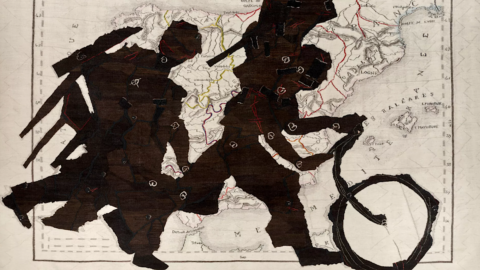Scene from the street in Montmartre testifies not only to Van Gogh's fascination with a rapidly changing city, but also to his contacts with the Parisian avant-garde art. Indeed, from the moment he arrived in Paris, Van Gogh multiplied his interactions and visits to art exhibitions. Both at the Académie Cormon, where he enrolled, and at the shop of the color supplier known as Le Père Tanguy, which was at the foot of Montmartre on rue Clauzel. Van Gogh met and associated with many artists, including Henri de Toulouse-Lautrec, Emile Bernard, Louis Anquetin and John Russell. Both in Père Tanguy's workshop and in the Boussod-Valadon gallery directed by his brother, he quickly became familiar with the art of Claude Monet, Paul Gauguin, Camille Pissarro, Pierre-Auguste Renoir and many others. Most importantly, in January 1887, a few weeks before executing this painting, Van Gogh befriended Paul Signac, who introduced him to Seurat's scientific theory of colours, and took him to paint with him on numerous occasions in Paris and Asnières.
All these encounters and influences led Van Gogh to abandon the dark tones of his early works and embrace a new, more vibrant and colorful palette. His touch becomes lighter, his pigments merge to create effects of transparency and light. Preserved for nearly a century in the same family, Scène de rue à Montmartre is a seminal work in Van Gogh's oeuvre. It is a testament to his contact with a new city, Paris, the capital of the XNUMXth century, but also with the art of the Impressionists and the avant-gardes which led him to abandon the dark tones of his early works and develop the unique colouristic palette and style which they will consecrate it as one of the greatest masters of Modern Art.
The street scene in Montmartre thus testifies not only to Van Gogh's fascination with a rapidly evolving city, but also to his contacts with the various Parisian avant-gardes. As soon as he arrived in Paris, Van Gogh multiplied his contacts. Both the Cormon Academy, where he enrolled, and the paint merchant Julien Tanguy (known as Father Tanguy), he has met many artists, including the first, Toulouse-Lautrec, Bernard, Anquetin or Russell. Both from Father Tanguy's Boussot Valadon and from his brother, he familiarized himself with the art of Monet, Gauguin, Pissarro, Renoir and many others. Most importantly, in January 1887, just a few weeks before this painting was to be executed, Van Gogh met Signac, who introduced him to the scientific theory of colors and brought him to paint with him on numerous occasions, Paris and Asnières.
These meetings push Van Gogh to abandon the dark tones of his early works to develop a new palette, already visible in the present work. His touch becomes lighter, his pigments dilute to create effects of transparency and the light enters his paintings. Never fully adopting the techniques of his fellow artists – Van Gogh would never have become an Impressionist or a Pointillist – the painter has developed a new mastery of color and composition, forging his own style to fully enter modernity. This plastic revolution is already present in Scène de rue in Montmartre, where the milky blue of the sky meets the greens and mauves of the barrier, contrasting with the yellow of the headdresses in the foreground. Even his technique evolves, contrasting the graphic character of the palisade with the free and removed touch of the rest of the composition. The street scene in Montmartre therefore stands out as a seminal work in the painter's art. It was in Montmartre, during this spring of 1887, that Van Gogh trained as a painter. During this short but incredibly fruitful period, he tackled the various avant-gardes and explored the different facets of modernity to finally lay the foundations of his inimitable style.





